How to divide one instructor into all, so that everyone gets two. Best practice in IT training
The field of education is very conservative. It’s hard to come up with something revolutionary, and it’s even harder to introduce innovation into the learning process. So it turns out that teaching the most advanced technologies in many institutions still resembles school melancholy and therefore is ineffective.
In the Network Academy LANIT, a new training format was developed, based on scientific research - how a person learns and how soon forgets new information, what factors distract attention and in what conditions training is more effective. I must say right away, thanks to the new methods, exam results improved by 30%. In this article I will talk about the scientific facts that have so affected the effectiveness of our training. You can use them anywhere - in self-study, and in public speaking, and in the preparation of presentations.

The emergence of Wikipedia and various online resources with educational materials has generated questions from the series “Why now to learn at all, if all the necessary information is at hand?”
')
Perhaps you will find the necessary section more quickly on the web than in paper textbooks or encyclopedias, but how much you understand from it depends on your current knowledge of a particular field. One of my desktop books was the Skanavi task book. But hardly free access to it on the web will automatically make at least someone smarter.
Technology provides only new tools to convey knowledge, but knowledge still needs to be learned.
Other innovations in the field of education cause a similar attitude, for example, proposals to distribute to everyone on a tablet or a virtual reality helmet. The effectiveness of a particular technique is not indicated by the tools that it uses, but by the results (for example, exam grades) it gives.
Unfortunately, it is impossible to train thousands of people, only to test the new technique - in education there are no conditions for large-scale experiments. Therefore, we in “Network Academy LANIT” went another way: we decided to design a more effective form of education, based on serious research in the field of psychology, pedagogy, and neurophysiology.
What researches formed the basis of the new educational format, which we called “Personal Learning”?
In 1984, Benjamin Bloom, perhaps known to you as the creator of Bloom’s famous taxonomy , explored the most effective ways to learn. Let me remind you that we are talking about classical education, because information technology at that time has not yet penetrated into education.
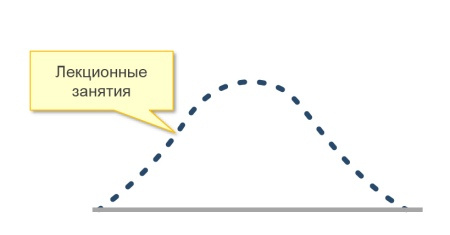 Source: The Sigma Problem: One of the One-to-One Tutoring. B.Bloom, Educational Researcher (1984)
Source: The Sigma Problem: One of the One-to-One Tutoring. B.Bloom, Educational Researcher (1984)
This is the normal distribution of marks on the exam. Most lecturers show good and average results. The number of brilliant answers, like the bad ones, makes up a small proportion of the total. How to improve these results?
It turns out that purposeful testing of knowledge and skills is guaranteed to give the best result.
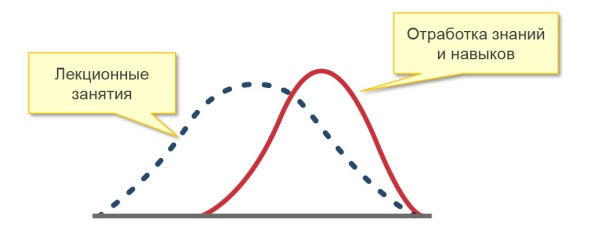
Now a tough drill is often used in distance learning - until you master the material, you can not go further. But, for example, I have such a hollowing of knowledge causes a persistent aversion.
According to Bloom's research, individual lessons bring the best results.
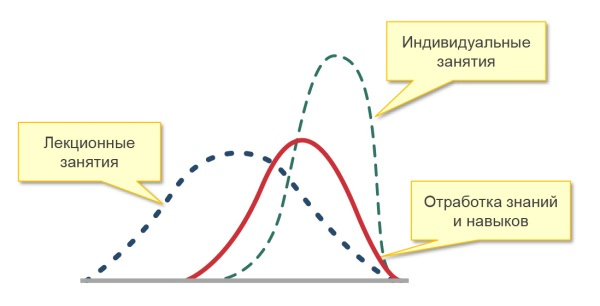
If we recall that these charts relate to people, it turns out that after the lectures at the exam, 50 students are conditionally scored a passing grade, and half will be eliminated. And if a separate teacher will work with each of the failed students, 98% of the entire audience will pass the exam successfully.
 A source
A source
Imagine how cool it is! We could translate half of the audience from “losers” to good and excellent students (in the picture below I painted them green) simply by changing the form of training.

How to implement it in practice? Unfortunately, teachers do not have time for personal lessons with everyone, and even if it were possible, such an approach turns out to be very expensive.
But let's not give up the hard idea. We will try to free the teacher as much as possible, then he will be able to devote time to each student. Let's replace the live lecture with a video for this, and students will watch it while sitting in the classroom. This is not about distance education, but about familiar full-time education, although using a computer to watch a video.
Despite the triviality of this idea, there is a small miracle. Now all the time that the teacher used to spend on lecturing, is released for personal communication with students. Seeing that the student has mastered the material well, the teacher can transfer it to the next educational unit. Good achievers can be given really serious and interesting tasks. And with those who do not have time, you can work out personally.
We used this idea and in the training center we organized the “Personal Learning” format in a group, at times increasing the time for personal communication between a student and a teacher as part of group classes.

In addition, it turned out that the new method allows you to simultaneously teach students in different programs: if a teacher reads several courses, then in one class he can gather students who study completely different material.
However, the idea only looks simple, but its implementation "head on" will lead to disaster. Even the most interesting video cannot be watched for a long time, without interrupting at all. Therefore, you cannot show students a full record of the teacher’s performance for 45 minutes. And our course lasts 5 days for 8 hours!
 A source
A source
The effectiveness of the assimilation of the material is strongly influenced by what sense organs a person perceives information. If a student reads a book, he is able to perceive no more than 8% of the material. The video increases the share of the learned material to 40%. Speaking a new topic allows you to master 60% of the information. If a person discusses a new material and applies it in practice, he will learn up to 80% of the information.
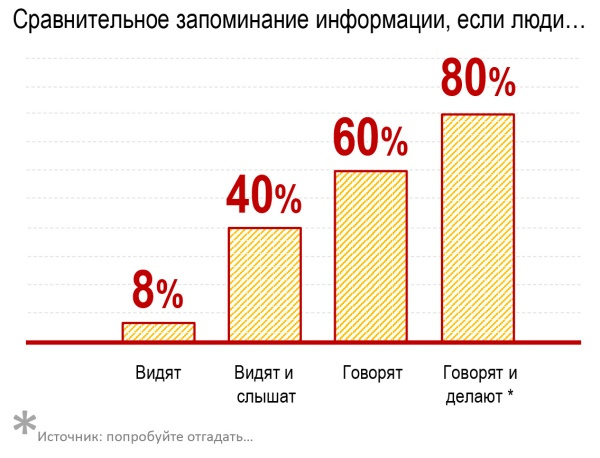
It is curious that this graph walks on thematic articles, but it does not rely on any research - the journals publish it with reference to each other. The lack of a scientific source makes the schedule an absolute fake, which, however, is true in essence: hardly anyone would argue with what we memorize better, connecting all the senses.
How to apply it? The easiest way, which technology provides, is to constantly vary the activity of students: after watching the video, arrange a test for students, give practical work. After practical classes, the person will want to return to the video again, because the computer “sucks” your attention. Pull the student into the real world, let him communicate with the teacher, with colleagues. Let the effect of "speaking", then you can again return to the video. It is such a constant (and frequent!) Change of activity incorporated in personal training.

Coursera contributed to the piggy bank of educational research. And not only by their innovations in the field of organization of the educational process. More interesting is the fact that millions of people gathered on this Internet site with training courses from leading universities in the world, which means there is a unique audience for collecting statistics with an unprecedented sample of countries, nations, races, social groups, etc.
Let's look at the attendance schedule of one of the Coursera courses for the entire time when it was available. What do you think, what are the periodic attendance peaks?

Guess what? This is the time before the intermediate verification work, when people begin to actively study. Not only the time when Russian students learn most effectively from Russian students can be called with one single word: session.
Daphne Koller , one of the founders of Coursera, commenting on the schedule, made a remarkable conclusion: “We have proved that postponing cases to the last moment is the most popular behavior strategy in the world.”
However, we are interested in another, more practical conclusion. The only way to get people to constantly learn is to ensure that their knowledge is constantly tested. Therefore, in personal training, students literally every few minutes answer at least one short question. The results are recorded in detail, and if the teacher sees that the test causes difficulties, he can immediately approach the student and help.
Now we understand how to achieve a good mastering of the material, but unfortunately, as soon as the material is mastered, it immediately inexorably begins to erase from our memory.
 A source
A source
How can you at least try to overcome forgetfulness?
A study published in the journal Science in 2011 revealed how well people take exams after various forms of study.

One-time training implies familiar lectures to us: students were told a new material once, and they took the exam. As can be seen on the graph, the results of such training are very mediocre.
It turned out to be more effective learning with repetition of the material. The pupils repeated the material until they learned it, only after that they proceeded to the next topic.
Against the background of this simple and rigid methodology, even complex learning strategies are less effective. (In this study, we tested the effectiveness of the method of establishing semantic correspondences - learning, in which associative links are built between the new material and already acquired information).
The best results on the exam were shown by a group of students on whom they applied the practice of active recall of the material. This is a simple technique known to everyone from school: at each lesson, the teacher asks the class questions about a previously completed topic.
Over time, any knowledge still disappears from the head. How often and how much time should be spent on active recall of information? The study of the speed with which people forget information, conducted a German psychologist Herman Ebbingauz . At the end of the XIX century, he built his famous forgetting curve.
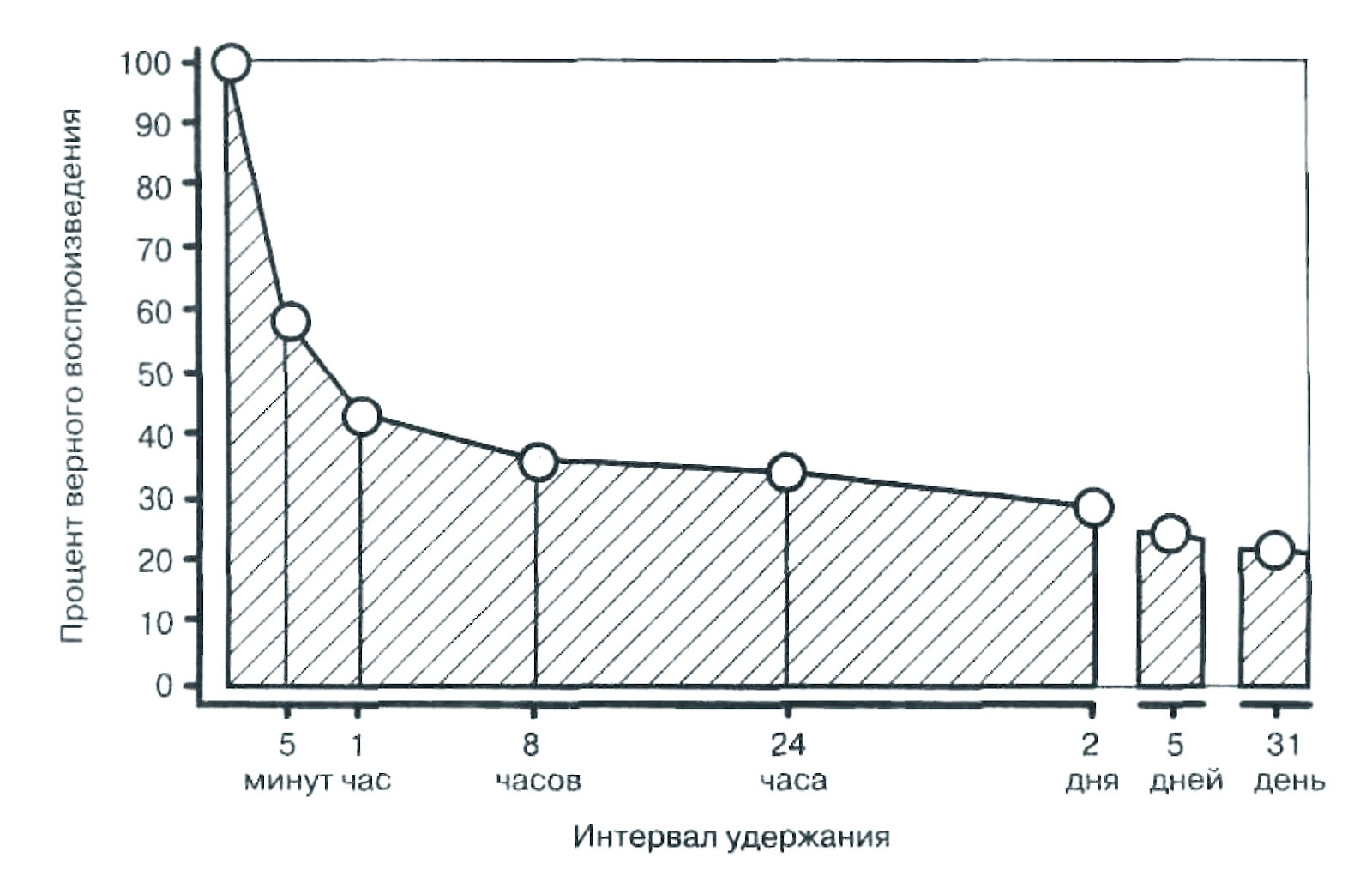
The graph clearly shows that a month later a person can remember only a small fraction of the information studied. In less than an hour, you will remember half the things you learned at the beginning.
How to deal with fast forgetting?
For information, for example, from a 45-minute lesson to remain in your head, if not forever, then for a long time, you need to repeat it in a day for 10 minutes, in a week spend 5 minutes on it, in a month - 2-4 minutes. Once again (forgive the pun), what to repeat is to try to actively recall the material. Do not read again, namely, remember.

What is the practical sense for a training center? Having built the training course in such a way that students remembered the studied material with the necessary frequency, you will do everything possible to overcome the Ebbingauz curve (although it is, of course, impossible to beat it). Listeners will not even understand why themselves, but their knowledge will remain in their heads for a very long time.
Argued that the lecturer ashamed to repeat. Probably, this prejudice arose from the scientific environment, where repeating, for example, in the text of the article is almost a crime. In fact, if nothing is repeated at all, in a month only one of the students will remember at least something heard.
Today it is extremely popular to present information in various forms. Listeners are not enough textbook. They want there to be exercises, games, hyperlinks, training activities, etc. How diverse should the educational material be?
The following experiment is not from the educational sphere, but it perfectly describes the behavior of a person in a situation of choice, and therefore, is applicable in the design of modern educational systems.
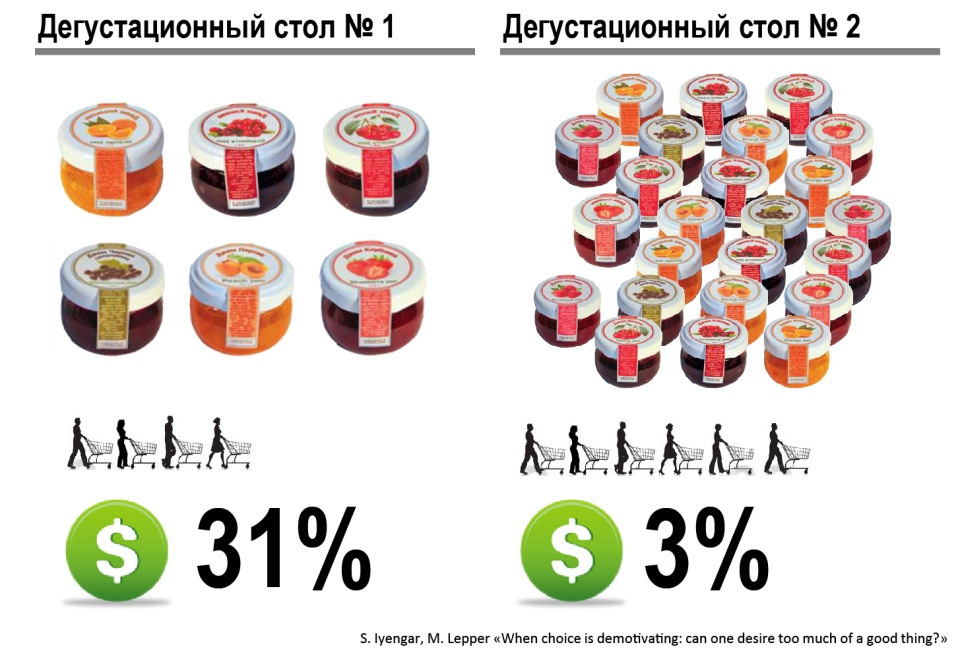
In the supermarket they put two tasting tables - with six and with twenty-four jars of jam. What do you think, which table had more people? Of course, people like the opportunity to choose, so the variety of tastes aroused more interest.
What do you think, at which table the tasting led to more purchases of jam? Oddly enough, shopping at the table with a large selection was ten times less (!). That's because the choice drove people into a stupor and they could not decide on their desires. Which of 24 flavors to prefer?
This psychological moment works everywhere. For example, the designers did a great job and made not 6 design options, but 24? Well done? No, they should all be fired! Now the customer will suffer for a long time, choosing the final version and most likely will just go to competitors, in whom he will easily choose his option from the three proposed ones.
A similar problem occurs in education. To the eyeballs, have we stuffed training materials with hypertext, games, additional materials? They only made it worse. In a situation where it is possible to go through the link and read and see there, our student will be at a loss and learn to stop altogether.
Nevertheless, we all want our training to be as interesting and entertaining as possible. And if the inclusion of a large number of additional materials is, as we have seen, badly, then at least it is worth making the course as interactive as possible. It turns out that everything is not so simple.
The use of interactive learning is not an absolute blessing. In confirmation of this, I cite another interesting study.
For three groups of students, different educational content was prepared - without interactive, with the possibility of choosing the sequence of studying the material (weak interactive) and with a pronounced interactive - educational games, interactive tests, etc.
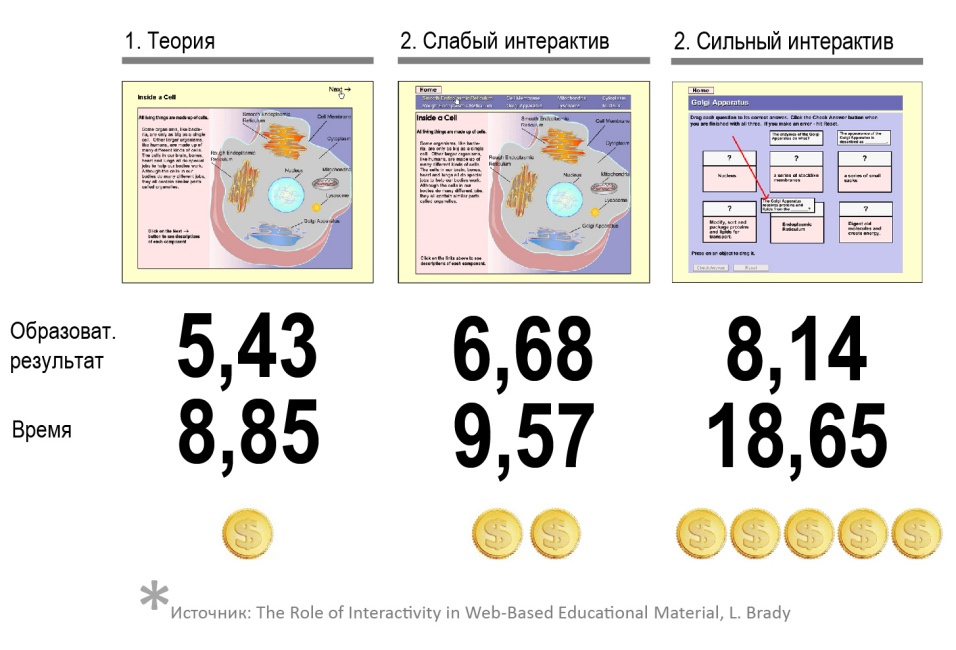
As you can see, the effectiveness of learning increases: the more interactive the course, the better. Now let's look at the time of studying materials and the cost of their creation. The first and second options are comparable, and for the third option it took twice the time of students and much more significant financial investments.
If we consider the increment in the quality of training we received for the money spent on the interactive work and the time that the students spent in class, instead of spending it with their family or even at work, it turns out that the game is not worth the candle.
In personal training, we try to determine the ideal trajectory of learning. This is not a wandering among a huge amount of educational materials, but a path that leads each listener along the most effective route for him, but in such a way that he does not encounter a difficult choice situation. Of course, we are developing interactive elements, but we are doing this in moderation, always remembering that we want to save both our time and the time of those who came to learn.
You can read more about how learning in the classroom looks like, how the idea of a new format originated, under the cat.
Our students, before and after the training, fill out a questionnaire in which they assess their own knowledge, share their impressions of teachers and opinions about how the equipment of the training center worked.
Based on their responses, we made a graph showing:

On the chart it is interesting to see how the answers and the results of students in personal and traditional full-time study differ.
Graduates of courses in the format of personal training are twice as high in assessing their own progress compared with students in the most effective full-time form. Of course, the estimates are subjective - people can create a lot. However, these graduates do better exams, tests - the difference is 30%!
It is curious that teachers and equipment graduates also rate higher, although full-time, and personal training takes place on the same equipment and is conducted by the same teachers. But people think that everything is better. Why? Due to the personal approach to the audience.
Of course, personal training in the group has its drawbacks. The most significant is the lack of social interaction, which usually occurs in the audience.
In Gladwell Malcolm's book, David and Goliath. How do outsiders beat the favorites? ” Provides a list of studies that tried to identify the optimal class size.

The general conclusion of these works is reduced to the given schedule. As you can see, the dependence of academic performance on class size is an inverted letter U. Very small and very large classes turned out to be equally bad. The best option is a medium-sized class, which allows discussing educational material, divided into subgroups to work it out.
All the group dynamics used by the teacher in full-time education - competitiveness, mutual aid of students, group discussion - disappears in personal training.
Of course, even in personal training, a good teacher can at some point interrupt the course and say to everyone: “Please put off the headphones, we will now work together, in a group.” But it is rather difficult to do this, because at this moment all students study different chapters of the educational material. Therefore, only some very general concepts can be discussed this way.
In addition to the inconvenience that the teacher may feel (just what I wrote above), it is worth mentioning the feelings of the students. Many are accustomed to study in a group and complain about the lack of communication.
Of course, in training, all communication is primarily aimed at achieving a better result, and the effectiveness of our new format is already high. Nevertheless, we are working to try to add an element of social interaction to personal learning. If you have ideas on how to do this, tell us about the comments, we will be very grateful.
In the Network Academy LANIT, a new training format was developed, based on scientific research - how a person learns and how soon forgets new information, what factors distract attention and in what conditions training is more effective. I must say right away, thanks to the new methods, exam results improved by 30%. In this article I will talk about the scientific facts that have so affected the effectiveness of our training. You can use them anywhere - in self-study, and in public speaking, and in the preparation of presentations.

The emergence of Wikipedia and various online resources with educational materials has generated questions from the series “Why now to learn at all, if all the necessary information is at hand?”
')
Perhaps you will find the necessary section more quickly on the web than in paper textbooks or encyclopedias, but how much you understand from it depends on your current knowledge of a particular field. One of my desktop books was the Skanavi task book. But hardly free access to it on the web will automatically make at least someone smarter.
Technology provides only new tools to convey knowledge, but knowledge still needs to be learned.
Other innovations in the field of education cause a similar attitude, for example, proposals to distribute to everyone on a tablet or a virtual reality helmet. The effectiveness of a particular technique is not indicated by the tools that it uses, but by the results (for example, exam grades) it gives.
Unfortunately, it is impossible to train thousands of people, only to test the new technique - in education there are no conditions for large-scale experiments. Therefore, we in “Network Academy LANIT” went another way: we decided to design a more effective form of education, based on serious research in the field of psychology, pedagogy, and neurophysiology.
What researches formed the basis of the new educational format, which we called “Personal Learning”?
We will teach everyone
In 1984, Benjamin Bloom, perhaps known to you as the creator of Bloom’s famous taxonomy , explored the most effective ways to learn. Let me remind you that we are talking about classical education, because information technology at that time has not yet penetrated into education.

This is the normal distribution of marks on the exam. Most lecturers show good and average results. The number of brilliant answers, like the bad ones, makes up a small proportion of the total. How to improve these results?
It turns out that purposeful testing of knowledge and skills is guaranteed to give the best result.

Now a tough drill is often used in distance learning - until you master the material, you can not go further. But, for example, I have such a hollowing of knowledge causes a persistent aversion.
According to Bloom's research, individual lessons bring the best results.

If we recall that these charts relate to people, it turns out that after the lectures at the exam, 50 students are conditionally scored a passing grade, and half will be eliminated. And if a separate teacher will work with each of the failed students, 98% of the entire audience will pass the exam successfully.

Imagine how cool it is! We could translate half of the audience from “losers” to good and excellent students (in the picture below I painted them green) simply by changing the form of training.

How to implement it in practice? Unfortunately, teachers do not have time for personal lessons with everyone, and even if it were possible, such an approach turns out to be very expensive.
But let's not give up the hard idea. We will try to free the teacher as much as possible, then he will be able to devote time to each student. Let's replace the live lecture with a video for this, and students will watch it while sitting in the classroom. This is not about distance education, but about familiar full-time education, although using a computer to watch a video.
Despite the triviality of this idea, there is a small miracle. Now all the time that the teacher used to spend on lecturing, is released for personal communication with students. Seeing that the student has mastered the material well, the teacher can transfer it to the next educational unit. Good achievers can be given really serious and interesting tasks. And with those who do not have time, you can work out personally.
We used this idea and in the training center we organized the “Personal Learning” format in a group, at times increasing the time for personal communication between a student and a teacher as part of group classes.

But what else gives personal training
- Everyone can learn at their own pace.
- Drawing up a personal training plan: you only learn what you do not know.
- You can create a personalized schedule.
- You can stop at any time.
- You can skip class and catch up.
In addition, it turned out that the new method allows you to simultaneously teach students in different programs: if a teacher reads several courses, then in one class he can gather students who study completely different material.
However, the idea only looks simple, but its implementation "head on" will lead to disaster. Even the most interesting video cannot be watched for a long time, without interrupting at all. Therefore, you cannot show students a full record of the teacher’s performance for 45 minutes. And our course lasts 5 days for 8 hours!
Basic rules for a good educational video
A source
People better perceive short videos and with great effort will be able to focus on the training video for more than 5 minutes. So break the video into fragments for a few minutes.
In psychology, an approximate reflex, first described by Russian physiologist Ivan Sechenov as early as 1863, is known - our ability to shift our attention to an unexpected event. You yourself can easily conduct an experiment and discover this ability in yourself: if you set up a TV without sound on the periphery of your view, and do your homework yourself, you will be constantly distracted against your changing television picture.
This universal reaction is actively exploited by TV advertising, usually changing the frame with the maximum frequency - every four seconds. This period is not accidental, it is also established during the experiment: this is the maximum time that physical contact with unfamiliar people can last so that they do not experience awkward sensations. That is, in 4 seconds we manage to realize the situation, but do not have time to “turn on” the emotions.
When creating a training video, perhaps, you should not compete with advertisers in the frequency of changing the picture, but you need to change the frame regularly.
When shooting an instructional video for the “Network Academy”, we not only constantly alternate plans, but also force teachers to work with cadres - draw something, underline, do some other additional action. These simple tricks also help keep the viewer's attention.
All these rules for creating a video sequence are designed to overcome the monotony of the educational process. They allow us to keep students interested throughout the entire 8-hour school day.

A source
YouTube style videos
People better perceive short videos and with great effort will be able to focus on the training video for more than 5 minutes. So break the video into fragments for a few minutes.
Permanent frame change
In psychology, an approximate reflex, first described by Russian physiologist Ivan Sechenov as early as 1863, is known - our ability to shift our attention to an unexpected event. You yourself can easily conduct an experiment and discover this ability in yourself: if you set up a TV without sound on the periphery of your view, and do your homework yourself, you will be constantly distracted against your changing television picture.
This universal reaction is actively exploited by TV advertising, usually changing the frame with the maximum frequency - every four seconds. This period is not accidental, it is also established during the experiment: this is the maximum time that physical contact with unfamiliar people can last so that they do not experience awkward sensations. That is, in 4 seconds we manage to realize the situation, but do not have time to “turn on” the emotions.
When creating a training video, perhaps, you should not compete with advertisers in the frequency of changing the picture, but you need to change the frame regularly.
Additional tricks
When shooting an instructional video for the “Network Academy”, we not only constantly alternate plans, but also force teachers to work with cadres - draw something, underline, do some other additional action. These simple tricks also help keep the viewer's attention.
All these rules for creating a video sequence are designed to overcome the monotony of the educational process. They allow us to keep students interested throughout the entire 8-hour school day.
How to assimilate and not forget - fight with human nature

The effectiveness of the assimilation of the material is strongly influenced by what sense organs a person perceives information. If a student reads a book, he is able to perceive no more than 8% of the material. The video increases the share of the learned material to 40%. Speaking a new topic allows you to master 60% of the information. If a person discusses a new material and applies it in practice, he will learn up to 80% of the information.

It is curious that this graph walks on thematic articles, but it does not rely on any research - the journals publish it with reference to each other. The lack of a scientific source makes the schedule an absolute fake, which, however, is true in essence: hardly anyone would argue with what we memorize better, connecting all the senses.
How to apply it? The easiest way, which technology provides, is to constantly vary the activity of students: after watching the video, arrange a test for students, give practical work. After practical classes, the person will want to return to the video again, because the computer “sucks” your attention. Pull the student into the real world, let him communicate with the teacher, with colleagues. Let the effect of "speaking", then you can again return to the video. It is such a constant (and frequent!) Change of activity incorporated in personal training.

Coursera contributed to the piggy bank of educational research. And not only by their innovations in the field of organization of the educational process. More interesting is the fact that millions of people gathered on this Internet site with training courses from leading universities in the world, which means there is a unique audience for collecting statistics with an unprecedented sample of countries, nations, races, social groups, etc.
Let's look at the attendance schedule of one of the Coursera courses for the entire time when it was available. What do you think, what are the periodic attendance peaks?

Guess what? This is the time before the intermediate verification work, when people begin to actively study. Not only the time when Russian students learn most effectively from Russian students can be called with one single word: session.
Daphne Koller , one of the founders of Coursera, commenting on the schedule, made a remarkable conclusion: “We have proved that postponing cases to the last moment is the most popular behavior strategy in the world.”
However, we are interested in another, more practical conclusion. The only way to get people to constantly learn is to ensure that their knowledge is constantly tested. Therefore, in personal training, students literally every few minutes answer at least one short question. The results are recorded in detail, and if the teacher sees that the test causes difficulties, he can immediately approach the student and help.
Now we understand how to achieve a good mastering of the material, but unfortunately, as soon as the material is mastered, it immediately inexorably begins to erase from our memory.

How can you at least try to overcome forgetfulness?
A study published in the journal Science in 2011 revealed how well people take exams after various forms of study.

One-time training implies familiar lectures to us: students were told a new material once, and they took the exam. As can be seen on the graph, the results of such training are very mediocre.
It turned out to be more effective learning with repetition of the material. The pupils repeated the material until they learned it, only after that they proceeded to the next topic.
Against the background of this simple and rigid methodology, even complex learning strategies are less effective. (In this study, we tested the effectiveness of the method of establishing semantic correspondences - learning, in which associative links are built between the new material and already acquired information).
The best results on the exam were shown by a group of students on whom they applied the practice of active recall of the material. This is a simple technique known to everyone from school: at each lesson, the teacher asks the class questions about a previously completed topic.
Over time, any knowledge still disappears from the head. How often and how much time should be spent on active recall of information? The study of the speed with which people forget information, conducted a German psychologist Herman Ebbingauz . At the end of the XIX century, he built his famous forgetting curve.

The graph clearly shows that a month later a person can remember only a small fraction of the information studied. In less than an hour, you will remember half the things you learned at the beginning.
How to deal with fast forgetting?
For information, for example, from a 45-minute lesson to remain in your head, if not forever, then for a long time, you need to repeat it in a day for 10 minutes, in a week spend 5 minutes on it, in a month - 2-4 minutes. Once again (forgive the pun), what to repeat is to try to actively recall the material. Do not read again, namely, remember.

What is the practical sense for a training center? Having built the training course in such a way that students remembered the studied material with the necessary frequency, you will do everything possible to overcome the Ebbingauz curve (although it is, of course, impossible to beat it). Listeners will not even understand why themselves, but their knowledge will remain in their heads for a very long time.
Argued that the lecturer ashamed to repeat. Probably, this prejudice arose from the scientific environment, where repeating, for example, in the text of the article is almost a crime. In fact, if nothing is repeated at all, in a month only one of the students will remember at least something heard.
A large selection of interactive educational materials is great. Or not?
Today it is extremely popular to present information in various forms. Listeners are not enough textbook. They want there to be exercises, games, hyperlinks, training activities, etc. How diverse should the educational material be?
The following experiment is not from the educational sphere, but it perfectly describes the behavior of a person in a situation of choice, and therefore, is applicable in the design of modern educational systems.

In the supermarket they put two tasting tables - with six and with twenty-four jars of jam. What do you think, which table had more people? Of course, people like the opportunity to choose, so the variety of tastes aroused more interest.
What do you think, at which table the tasting led to more purchases of jam? Oddly enough, shopping at the table with a large selection was ten times less (!). That's because the choice drove people into a stupor and they could not decide on their desires. Which of 24 flavors to prefer?
This psychological moment works everywhere. For example, the designers did a great job and made not 6 design options, but 24? Well done? No, they should all be fired! Now the customer will suffer for a long time, choosing the final version and most likely will just go to competitors, in whom he will easily choose his option from the three proposed ones.
A similar problem occurs in education. To the eyeballs, have we stuffed training materials with hypertext, games, additional materials? They only made it worse. In a situation where it is possible to go through the link and read and see there, our student will be at a loss and learn to stop altogether.
Nevertheless, we all want our training to be as interesting and entertaining as possible. And if the inclusion of a large number of additional materials is, as we have seen, badly, then at least it is worth making the course as interactive as possible. It turns out that everything is not so simple.
The use of interactive learning is not an absolute blessing. In confirmation of this, I cite another interesting study.
For three groups of students, different educational content was prepared - without interactive, with the possibility of choosing the sequence of studying the material (weak interactive) and with a pronounced interactive - educational games, interactive tests, etc.

As you can see, the effectiveness of learning increases: the more interactive the course, the better. Now let's look at the time of studying materials and the cost of their creation. The first and second options are comparable, and for the third option it took twice the time of students and much more significant financial investments.
If we consider the increment in the quality of training we received for the money spent on the interactive work and the time that the students spent in class, instead of spending it with their family or even at work, it turns out that the game is not worth the candle.
In personal training, we try to determine the ideal trajectory of learning. This is not a wandering among a huge amount of educational materials, but a path that leads each listener along the most effective route for him, but in such a way that he does not encounter a difficult choice situation. Of course, we are developing interactive elements, but we are doing this in moderation, always remembering that we want to save both our time and the time of those who came to learn.
You can read more about how learning in the classroom looks like, how the idea of a new format originated, under the cat.
As in the "Network Academy" introduced personal training and what came of it
All the results of the research described by me are used in our training center in the format of “Personal Training”.
When I came to work here, the first thing I decided to try out was the new format. The training went so smoothly, that even a little lulled me.
I went through Advanced Excel and thought that I already know everything in the tables. And here again - a control question after another topic. It was here that I realized that I had overslept the last topic with open eyes: I heard everything, but it turned out that I did not, because I could not answer. Surprisingly, I “woke up”, reviewed this episode again, and further more consciously participated in the training. In the traditional full-time study, such an “awakening” could not happen, but with self-learning, where there is no control at all, this is completely impossible.
You should know how many hours of life this training format has saved me, because thanks to it, the summary tables do not spoil my mood.
So, any student who has chosen “Personal Learning” is studying in the classroom at his or her monitor. He watches short videos that reveal certain aspects of the topic, passes tests, does practical exercises. The structure of training materials makes him repeat the study with the necessary frequency. Every five minutes, questions keep students in good shape and make them watch the video with great attention.
From time to time the teacher speaks with each student - he answers questions, once again explains difficult to understand places, depending on the situation, may suggest additional tasks or transfer the student to a new topic, determining his individual educational trajectory.
The idea of such a format in school education is known for a very long time under the name “Inverted Class”.
 A source
A source
In the West, they have been teaching this for more than 15 years. And "Network Academy", as well as other participants of the Russian education market, in 2010, a variation of this idea on a franchise was offered by a foreign company. Then the training center was the first who was ready to experiment on this field. In many ways, because the new form of education seemed to have used already known scientific results in practice.
Before signing the contract, an idea appeared to try to make learning content on your own. The result of this experiment turned out to be more interesting than the western counterpart.
Then our experts began to refine their own methods of content production, applied a lot of their chips. For example, in the original method there was no idea of constant testing.
Own development turned out to be cheaper (translation into Russian of all materials was a very expensive pleasure), and the whole product exceeded the offer of Western partners in many ways. By the way, the training center did not hide anything from them and honestly told about their work. Now we ourselves distribute materials for personal training in the field of IT on the franchise and are happy to share the methodological developments with everyone.
Perhaps this is exactly how innovation in education is born. It’s always hard to come up with something revolutionary from scratch. More often, you are inspired by the idea, transform it, hone the details, and as a result you get a completely new product, which has no analogues.
When I came to work here, the first thing I decided to try out was the new format. The training went so smoothly, that even a little lulled me.
I went through Advanced Excel and thought that I already know everything in the tables. And here again - a control question after another topic. It was here that I realized that I had overslept the last topic with open eyes: I heard everything, but it turned out that I did not, because I could not answer. Surprisingly, I “woke up”, reviewed this episode again, and further more consciously participated in the training. In the traditional full-time study, such an “awakening” could not happen, but with self-learning, where there is no control at all, this is completely impossible.
You should know how many hours of life this training format has saved me, because thanks to it, the summary tables do not spoil my mood.
So, any student who has chosen “Personal Learning” is studying in the classroom at his or her monitor. He watches short videos that reveal certain aspects of the topic, passes tests, does practical exercises. The structure of training materials makes him repeat the study with the necessary frequency. Every five minutes, questions keep students in good shape and make them watch the video with great attention.
From time to time the teacher speaks with each student - he answers questions, once again explains difficult to understand places, depending on the situation, may suggest additional tasks or transfer the student to a new topic, determining his individual educational trajectory.
The idea of such a format in school education is known for a very long time under the name “Inverted Class”.

In the West, they have been teaching this for more than 15 years. And "Network Academy", as well as other participants of the Russian education market, in 2010, a variation of this idea on a franchise was offered by a foreign company. Then the training center was the first who was ready to experiment on this field. In many ways, because the new form of education seemed to have used already known scientific results in practice.
Before signing the contract, an idea appeared to try to make learning content on your own. The result of this experiment turned out to be more interesting than the western counterpart.
Then our experts began to refine their own methods of content production, applied a lot of their chips. For example, in the original method there was no idea of constant testing.
Own development turned out to be cheaper (translation into Russian of all materials was a very expensive pleasure), and the whole product exceeded the offer of Western partners in many ways. By the way, the training center did not hide anything from them and honestly told about their work. Now we ourselves distribute materials for personal training in the field of IT on the franchise and are happy to share the methodological developments with everyone.
Perhaps this is exactly how innovation in education is born. It’s always hard to come up with something revolutionary from scratch. More often, you are inspired by the idea, transform it, hone the details, and as a result you get a completely new product, which has no analogues.
Personal training in numbers
Our students, before and after the training, fill out a questionnaire in which they assess their own knowledge, share their impressions of teachers and opinions about how the equipment of the training center worked.
Based on their responses, we made a graph showing:
- subjective progress in knowledge - if before a course a person assessed his knowledge by one point, and after - by ten, then his progress would be nine points;
- the objective result of the assessment of knowledge during testing (max - 100%);
- impressions from teachers (max - 5 points);
- impressions about the work of the equipment of the training center (max - 5 points).

On the chart it is interesting to see how the answers and the results of students in personal and traditional full-time study differ.
Graduates of courses in the format of personal training are twice as high in assessing their own progress compared with students in the most effective full-time form. Of course, the estimates are subjective - people can create a lot. However, these graduates do better exams, tests - the difference is 30%!
It is curious that teachers and equipment graduates also rate higher, although full-time, and personal training takes place on the same equipment and is conducted by the same teachers. But people think that everything is better. Why? Due to the personal approach to the audience.
When everything is too good, it is also a little bad
Of course, personal training in the group has its drawbacks. The most significant is the lack of social interaction, which usually occurs in the audience.
In Gladwell Malcolm's book, David and Goliath. How do outsiders beat the favorites? ” Provides a list of studies that tried to identify the optimal class size.

The general conclusion of these works is reduced to the given schedule. As you can see, the dependence of academic performance on class size is an inverted letter U. Very small and very large classes turned out to be equally bad. The best option is a medium-sized class, which allows discussing educational material, divided into subgroups to work it out.
One teacher explains: “The source of the vitality of any class is discussion, and for its management a certain critical mass is necessary. Currently I work with classes where there are students who never participate in discussions at all, it’s some kind of nightmare. If there are too few students, the discussion suffers too. It seems illogical, because I have always believed that timid children, who find it embarrassing to perform in a class of 32 students, would rather talk in a class of 16 people. But I was wrong. Timid children were timid, regardless of class size. And if the class is too small, then among the participants there is not a wide range of opinions necessary for the discussion to develop. In addition, a very small group is devoid of the energy that results from friction between people. ”
(Gladwell Malcolm "David and Goliath. How Outsiders Beat the Favorites" )
All the group dynamics used by the teacher in full-time education - competitiveness, mutual aid of students, group discussion - disappears in personal training.
Of course, even in personal training, a good teacher can at some point interrupt the course and say to everyone: “Please put off the headphones, we will now work together, in a group.” But it is rather difficult to do this, because at this moment all students study different chapters of the educational material. Therefore, only some very general concepts can be discussed this way.
In addition to the inconvenience that the teacher may feel (just what I wrote above), it is worth mentioning the feelings of the students. Many are accustomed to study in a group and complain about the lack of communication.
Of course, in training, all communication is primarily aimed at achieving a better result, and the effectiveness of our new format is already high. Nevertheless, we are working to try to add an element of social interaction to personal learning. If you have ideas on how to do this, tell us about the comments, we will be very grateful.
Source: https://habr.com/ru/post/338308/
All Articles